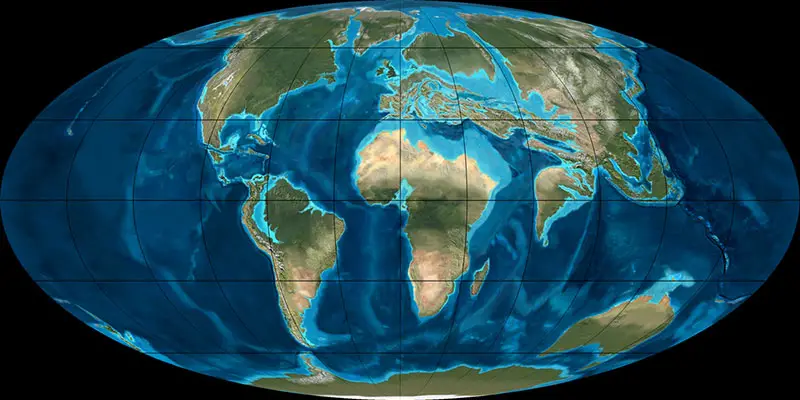†Biretia (Parapithecidae)
Biretia ist eine Primatengattung innerhalb der Familie Parapithecidae, deren 4 Mitglieder ab dem frühen Eozän lebten, das vor ungefähr 56 Millionen Jahren begann und bis vor vor 33,9 Millionen Jahren andauerte. Viele Überreste wurden in Algerien gefunden.
Biretia ist der Gattungsname von drei Primatenarten, die im Eozän in Nordafrika verbreitet waren.
Biretia gehört zur Familie Parapithecidae, was die Gattung als urtümliche Trockennasenaffen ausweist.
Jüngste Ausgrabungen in der Birket Qarun Lokalität (BQ-2) in der Fayum führten zur Entdeckung von zwei Arten von Biretia (B. fayumensis und B. megalopsis), beide etwa 37 Millionen Jahre alt (Seiffert et al., 2005). Biretia ist eine Gattung von frühen afrikanischen Anthropoiden, die sehr klein waren. B. fayumensis wog nur etwa 160 - 273 Gramm, wie man durch Zahnvergleiche mit heute lebenden Primaten abschätzen kann. B. megalopsis war größer als B. fayumensis und hatte große Augenhöhlen, was darauf hindeutet, dass der Primat während der Nacht aktiv war. Biretia wird in die Ordnung Parapithecoidea gestellt, eine der Primatenordnungen, die in der Fayum gefunden wurden. Sie ähnelten heutigen Marmosetten, mit einem Gebiss, wie es für Blätterfresser charakteristisch ist. Die Zahnformel lautete wie bei Neuweltaffen 2.1.3.3. Die gemeinsamen abgeleiteten Merkmale der Zähne von Biretia und jüngeren Parapitheciden deuten auf einen vielfältigen und alten Stamm hin, zu dem auch Algeripithecus gehören könnte.
| Physiologie | |
|---|---|
| Gewicht: | ? |
| Schwestertaxa | |
Biretia fayumensis
Das Typusexemplar mit der Bezeichnung CGM 83658 ist ein Unterkiefer, in dem zwei Molare (M2 und M3) erhalten sind. Der Fund stammt aus dem Umm Rigl Member der Birket Qarun Formation (Fayum, Ägypten) und ist zwischen 37,2 und 33,9 Millionen Jahre alt. Basierend auf der Morphologie des Fundes kann man auf die Ökologie schließen: Biretia fayumensis war ein Allesfresser, der sein Leben auf Bäumen verbrachte.
| Sammlung | Kommentar zum Fundort | Epoche, Alter | Geologie, Formation | Kommentar zur Sammlung |
|---|---|---|---|---|
| Birket Qarun 2 | Birket Qarun | BK-2; BQ-2; BQ 2; Birket Qarun Locality 2 | ||
| Kommentar z. Stratigraphie | Lithographie | Kommentar z. Taxonomie | ||
| "183 m below the contact of the Qasr el Sagha and Jebel Qatrani formations... This horizon was recently placed in the lowermost (Umm Rigl) Member of the Qasr el Sagha Formation, but renewed work indicates that these fossiliferous alluvial sediments are lithologically distinctive and best retained in the Birket Qarun Formation"; according to Seiffert et al. 2005 the fossilferous beds are "229 m below Quarry L-41," "about 5 to 15 cm thick," and based on new paleomagnetic data within C17n.1n and "earliest Priabonian" | "bioclastic ironstone conglomerate" (Seiffert et al. 2003) or "ironstone-rich fining upward sequences of medium-to-fine grained sands and muds" | additional taxa that are not primates and therefore not worth describing include "proboscideans, hyracoids, herodotiines, ptolemaiids, creodonts, anomaluroid and hystricognathous rodents, chiropterans, and insectivores" (Seiffert et al. 2005) |
Biretia megalopsis
Das Typusexemplar mit der Bezeichnung CGM 83661 ist ein Teil eines Unterkiefers mit zwei Molaren (M2 und M3). Der Fund stammt aus dem Umm Rigl Member der Birket Qarun Formation (Fayum, Ägypten) und ist zwischen 37,2 und 33,9 Millionen Jahre alt. Basierend auf der Morphologie des Fundes kann man auf die Ökologie schließen: Biretia megalopsis war ein Allesfresser, der sein Leben auf Bäumen verbrachte.
| Sammlung | Kommentar zum Fundort | Epoche, Alter | Geologie, Formation | Kommentar zur Sammlung |
|---|---|---|---|---|
| Birket Qarun 2 | Birket Qarun | BK-2; BQ-2; BQ 2; Birket Qarun Locality 2 | ||
| Kommentar z. Stratigraphie | Lithographie | Kommentar z. Taxonomie | ||
| "183 m below the contact of the Qasr el Sagha and Jebel Qatrani formations... This horizon was recently placed in the lowermost (Umm Rigl) Member of the Qasr el Sagha Formation, but renewed work indicates that these fossiliferous alluvial sediments are lithologically distinctive and best retained in the Birket Qarun Formation"; according to Seiffert et al. 2005 the fossilferous beds are "229 m below Quarry L-41," "about 5 to 15 cm thick," and based on new paleomagnetic data within C17n.1n and "earliest Priabonian" | "bioclastic ironstone conglomerate" (Seiffert et al. 2003) or "ironstone-rich fining upward sequences of medium-to-fine grained sands and muds" | additional taxa that are not primates and therefore not worth describing include "proboscideans, hyracoids, herodotiines, ptolemaiids, creodonts, anomaluroid and hystricognathous rodents, chiropterans, and insectivores" (Seiffert et al. 2005) |
Biretia piveteaui
Das Typusexemplar mit der Bezeichnung BRT 17-84 ist ein rechter unterer Backenzahn (M1). Der Fund stammt aus Bir El Ater in Algerien ist zwischen 40,4 und 33,9 Millionen Jahre alt. Basierend auf der Morphologie des Fundes kann man auf die Ökologie schließen: Biretia piveteaui war ein Allesfresser, der sein Leben auf Bäumen verbrachte.
| Sammlung | Epoche, Alter | Kommentar zur Sammlung |
|---|---|---|
| Bir El Ater | Southern slope of Nementcha Mountains | |
| Lithographie | ||
| sandy |
Literatur
E. R. Seiffert, E. L. Simons, W. C. Clyde, J. B. Rossie, Y. Attia, T. M. Bown, P. Chatrath, M. E. Mathison 2005, Basal anthropoids from Egypt and the antiquity of Africa's higher primate radiation. Science. 310, p. 300 - 304C. Delmer, M. Mahboubi, R. Tabuce, P. Tassy 2006, A new species of Moeritherium (Proboscidea, Mammalia) from the Eocene of Algeria: New perspectives on the ancestral morphotype of the genus. Palaeontology. 49:2, p. 421 - 434
J.-J. Jaeger, K. C. Beard, Y. Chaimanee, M. Salem, M. Benammi, O. Hlal, P. Coster, A. A. Bilal, P. Duringer, M. Schuster, X. Valentin, B. Marandat, L. Marivaux, E. Metais, O. Hammuda, M. Brunet 2010, Late middle Eocene epoch of Libya yields earliest known radiation of African anthropoids. Nature. 467:2, p. 1095 - 1098, DOI: 10.1038/nature09425
